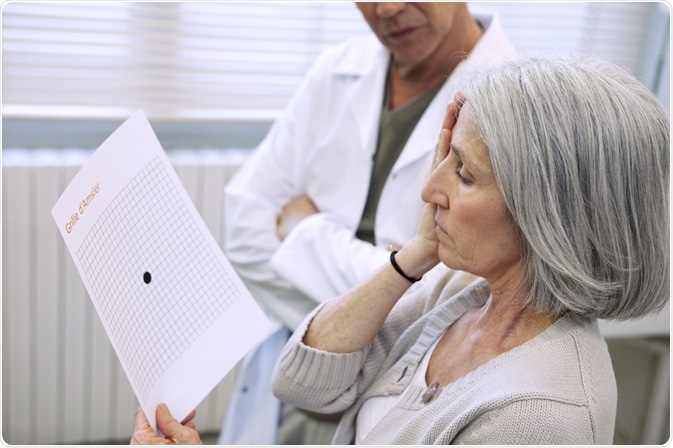Age-related macular degeneration (AMD) is a common eye condition that affects the central area of vision. It most commonly affects people age 50 and over, and can affect one eye or both eyes.
 Credit: Image Point Fr/Shutterstock.com
Credit: Image Point Fr/Shutterstock.com
AMD affects the macula, the part of the eye that provides clear central vision, and the retina, the thin layer of tissue that lines the back of the eye and receives light.
Light-sensitive cells in the macula are unable to function normally when a layer of support cells die. As the retina converts light into neural signals that trigger visual recognition in the brain, damage caused by AMD significantly affects the eye’s ability to convert these signals into images.
Yellow deposits (drusen) form beneath the retina, causing distorted and blurred vision, and over time the deposits increase in size and number. This causes blood vessels to grow beneath the retina (angiogenesis) which leak blood and damage the retina. Peripheral vision (side vision) may not be affected, but in late AMD, the ability to see directly ahead is lost.
Causes of age-related macular degeneration
The exact cause of AMD is unknown, but there are links to suggest that smoking, being overweight or having high blood pressure increase your chances of developing AMD.
Having a family history of AMD can also increase your chances of developing the disease, and there have been nearly 20 genes identified that can contribute to the risk of developing AMD. Research has shown that AMD is more common amongst Caucasian populations than Hispanics/Latinos or African-Americans.
To reduce the risk of developing AMD, a balanced, healthy diet is suggested along with regular exercise and avoiding smoking.
Symptoms of age-related macular degeneration
AMD does not usually present symptoms in its early and intermediate stages. There are two types of AMD, ‘wet AMD’ (neovascular AMD) and ‘dry AMD’ (geographic atrophy).
Wet AMD progresses quickly over a few weeks or months, while dry AMD progresses over a number of years. It is possible to have both wet and dry AMD in the same eye and each type can appear in any order.
Symptoms include:
- Blurred or distorted vision
- Inability to see anything in the centre of your vision
- Seeing straight lines as wavy (for instance text on a page, blinds, or streetlights)
- Colors not looking as bright as before
- Visual hallucinations
Stages of age-related macular degeneration
There are three stages of AMD and the disease can progress at different rates in each eye.
Early AMD
Vision loss is not commonly reported in early-stage AMD. It is diagnosed by the appearance of medium-sized drusen.
Intermediate AMD
Large drusen are present in intermediate AMD. Pigment changes in the retina can also be present alongside the large drusen, but vision loss is not always reported in intermediate stage AMD.
Late AMD
Patients with late AMD will report loss of vision due to the damage to the macula either through wet or dry AMD.
Diagnosis of age-related macular degeneration
A detailed eye exam can detect AMD. Common practices in diagnosing AMD are:
- Dilated eye exam: Eye drops are used to dilate the pupils, providing a clear view of the back of the eye. A magnifying lens is used to inspect the retina and optic nerve.
- Visual acuity test: A test to measure your ability to see at distances.
- Amsler grid: An Amsler grid is graph paper used to identify vision loss or distortion of straight lines.
- Fluorescein angiogram: A fluorescein angiography records the blood flow in the retina using a camera. Dye is injected intravenously and pictures are taken as the dye passes through the blood vessels in the retina to identify abnormal blood vessels or damage to the lining around the retina.
- Optical coherence tomography (OCT): OCT is used to capture detailed images of the retina. A cross-section of the retina is captured so that the thickness of each layer in the retina can be measured.
Treatment of age-related macular degeneration
Wet AMD is treated with regular injections of medicine into the eye to control the blood vessels in the retina. Occasionally photodynamic therapy (PDT), a form of phototherapy using light and photosensitizing chemicals, is also used to prevent vision from deteriorating further.
Dry AMD is not treated with injections, but instead sometimes treated with supplements to slow its progression. Vision aids (for instance magnifying lenses and computer and mobile apps to increase usability) are suggested to reduce the effects of AMD on your life.
Changes to your home environment can also be put into place, such as brighter lighting, and patients can undergo training to teach techniques allowing them to make the most of their remaining vision.
Prognosis for age-related macular degeneration
While AMD does not cause total blindness, the ability to carry out everyday activities such as reading, writing, recognizing faces, driving, or engaging in work requiring the ability to see small details may be impaired.
Further Reading